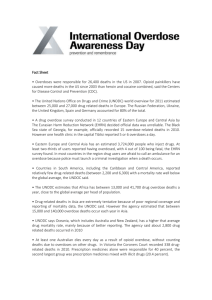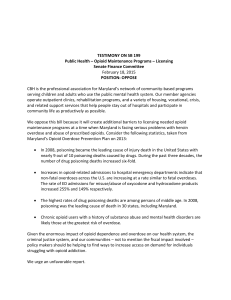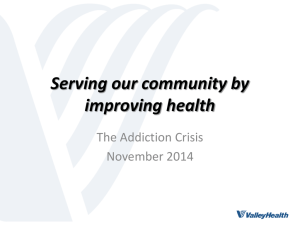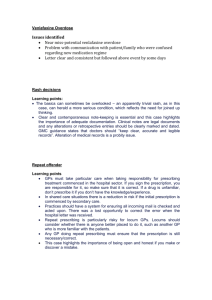The Epidemiology of Fatal Drug Overdoses: Potential for Prevention
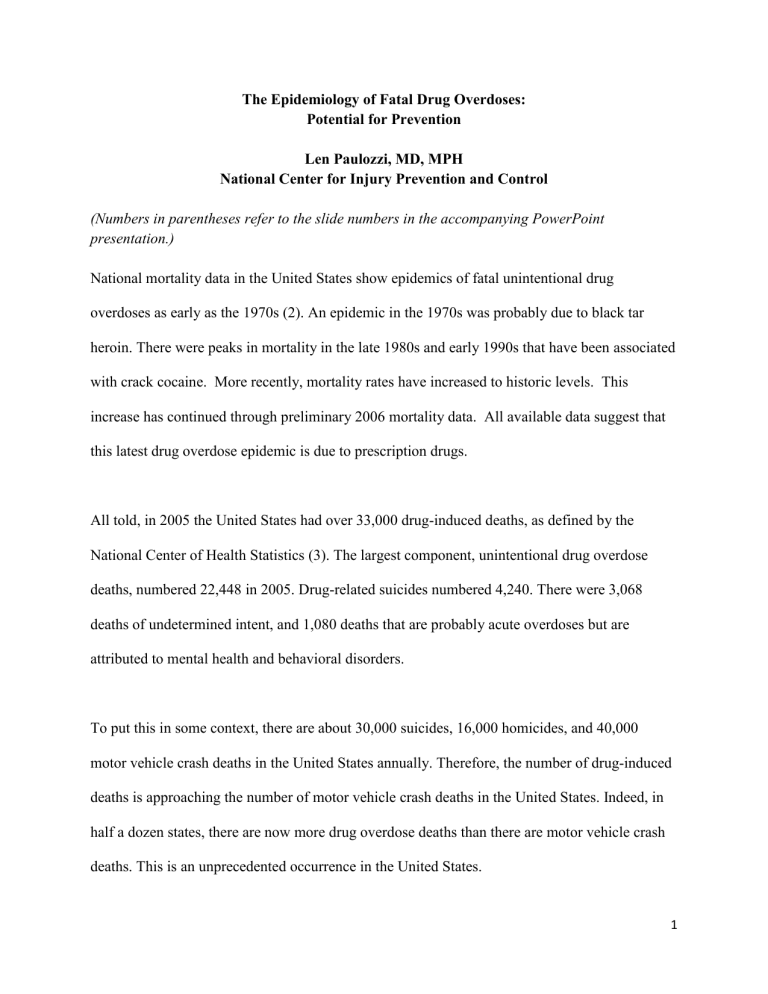
The Epidemiology of Fatal Drug Overdoses:
Potential for Prevention
Len Paulozzi, MD, MPH
National Center for Injury Prevention and Control
(Numbers in parentheses refer to the slide numbers in the accompanying PowerPoint presentation.)
National mortality data in the United States show epidemics of fatal unintentional drug overdoses as early as the 1970s (2). An epidemic in the 1970s was probably due to black tar heroin. There were peaks in mortality in the late 1980s and early 1990s that have been associated with crack cocaine. More recently, mortality rates have increased to historic levels. This increase has continued through preliminary 2006 mortality data. All available data suggest that this latest drug overdose epidemic is due to prescription drugs.
All told, in 2005 the United States had over 33,000 drug-induced deaths, as defined by the
National Center of Health Statistics (3). The largest component, unintentional drug overdose deaths, numbered 22,448 in 2005. Drug-related suicides numbered 4,240. There were 3,068 deaths of undetermined intent, and 1,080 deaths that are probably acute overdoses but are attributed to mental health and behavioral disorders.
To put this in some context, there are about 30,000 suicides, 16,000 homicides, and 40,000 motor vehicle crash deaths in the United States annually. Therefore, the number of drug-induced deaths is approaching the number of motor vehicle crash deaths in the United States. Indeed, in half a dozen states, there are now more drug overdose deaths than there are motor vehicle crash deaths. This is an unprecedented occurrence in the United States.
1
The mortality classification scheme has allowed identification of the numbers of deaths associated with specific types of drugs since 1999 (4). The major categories are heroin, cocaine, and opioid painkillers. In 1999, the numbers for these three categories were fairly comparable, with cocaine deaths just exceeding the opioid painkiller deaths. Thereafter, opioid pain killerrelated deaths rose faster than deaths involving cocaine, while heroin deaths remained stable. By
2005, opioid pain killers were involved in more deaths than the numbers of cocaine and heroin deaths combined. There is no reason to believe that these numbers gave come down since 2005, the last year of available data, and they probably have become substantially worse.
It is difficult to determine the relative contributions of different types of drugs to these deaths, because most have two, three, four, or five drugs involved. One approach is to attribute the death to the first-listed drug on the death certificate. Using this approach, prescription or over-thecounter drugs are the first-listed drug for about 50% of unintentional drug overdose deaths in
2005 (5). Illicit drugs—cocaine, heroin, and other illicits, including methamphetamine—account for about 40%. The last 10% consist of unspecified narcotics—a combination of prescription or street narcotics. It may be a reasonable to conclude that prescription drugs have accounted for anywhere between 50–60% of the drug overdose deaths in the United States since 2005.
Associated with the steep upward trend in overdose mortality has been a dramatic parallel increase in opioid sales since at least 1997, as recorded by the ARCOS program of the Drug
Enforcement Administration (6). And, because DEA data show a further increase in sales in
2006, overdose mortality rates have probably also risen since 2005.
2
Drug overdose mortality rates are higher among men than women, and they are highest among people 35–54 years of age. Starting in the 15–24 age group, the rates go up, peak in the 45–54 age group, and then drop off sharply. This mortality curve by age can be compared to the rate of prescribing opioid analgesics, if we use data for men from one state with a prescription drug monitoring program in 2002 (7). Prescriptions for analgesics track the mortality trend up to age
45–54 and then continue at high levels through the 85+ years age group. Similar patterns can be seen among women.
The different age patterns for mortality involving opioids and prescribing rates provide a clue as to the etiology of the opioid overdoses. If all such overdoses were innocent mistakes made with medication dosage, one might expect the mortality curve to parallel the prescribing curve through the life span. Mortality might even rise in the older age groups, assuming that older people are more likely to get confused with their medications. The data, however, suggest that the deaths in middle age have more to do with substance abuse than with innocent overdoses.
Medical examiner data from a number of states corroborate the idea that substance abuse is behind these deaths. Such data show a consistent picture, with large majorities of decedents having a history of substance abuse (8). Typically, half or more of the people dying of prescription drugs do not have a prescription recorded in state prescription drug monitoring programs for one or more of their drugs. Therefore, they must have obtained their drugs from drug diversion. In addition, substantial minorities of people dying from prescription drug overdoses are found with street drugs in their systems, suggesting that they are abusing drugs.
3
Another minority of those dying because of prescription drug use inject or snort or otherwise manipulate the drug to get high or exhibit behaviors associated with abuse, and many have a history of previous drug overdoses.
The geographic distribution of drug overdose mortality in the United States is shifting to more rural areas. As late as 1999, drug overdose death rates were still highest in the large central metropolitan areas, an historical pattern in the United States (9). By 2005, however, rates in the non-metro, noncore counties increased so dramatically that they became comparable to the rates of the most urban counties. This change is consistent with a February 2007 report in MMWR, which showed that the biggest increases in drug overdose deaths occurred in the most rural states. The change is also consistent with other reports of large increases in such rural states as
Maine and the Appalachian states. As of 2005, a map of the United States shows that unintentional and undetermined intent drug overdose deaths cluster in states along the
Appalachian Mountains in the East, in some of the New England states, in Florida, and in the
Southwest (10). It also indicates that some states have particularly low rates, as in New York, with a rate of 4.2, compared to Pennsylvania, with a rate of 11.9. Texas’ rate is also quite low compared to the rates of the surrounding states.
The case of New York State is instructive for what it suggests about legal strategies for managing the prescription drug overdose problem. New York has not necessarily always been exceptional in terms of its drug overdose death rates. During the 1979 to 1985 time period, when rates were much lower across the country, New York’s prescription drug overdose death rate was comparable to the rates of New Jersey and Pennsylvania and its other neighboring states (11).
4
During the 1989–1995 time period, however, a period that included the era of crack cocaine, rates rose for New York and its neighbors. During the 1999–2005 time period, the period of the prescription drug overdose epidemic, New York had no increase in its drug overdose death rates, while its neighboring states Massachusetts and Pennsylvania doubled their rates. This difference suggests that New York may have been managing prescription drugs better than its neighboring states.
Differences in opioid utilization also suggest that New York was handling opioids differently.
Oxycodone distributions per capita in milligrams/person from 2006, for example, show a wide range of distributions across the country, ranging from 5–50 mg/person to 250–600 mg/person, a
10-fold difference (12). Other maps for methadone and morphine show similar wide variations nationally and similar geographic patterns. Since it is unlikely that pain varies this much across the United States, the differences are more likely to be due to variations in marketing or differences in the rates of abuse of these drugs.
Examination of drug overdose mortality rates by county shed additional light on variations in state rates. New York was comparable to its neighbors in the 1979–1985 time period, when rates were relatively low; the median rate was .88/100,000 (13). By 1989–1995, however, a shift had begun, with lower age-adjusted rates for drug overdoses by county in upstate New York (14).
By the 1999 to 2005 time period, almost all the counties in New York State were in the lowest quartile for the region (15). Comparison of these county-level maps over time indicates that the lower rates in New York are not simply a function of lower rates in New York City. This finding suggests that statewide policies in New York may be responsible for the state’s lower rates (16).
5
And it offers some promise that states can control their prescription drug overdose problems, even when the situation is worsening nationwide.
In fact, the dominant role of prescription drugs in the current situation creates opportunities to use legal measures to address the problem, measures that cannot be applied to street drugs (17).
For example, we don’t license the sources of drugs for street drugs; we don’t have special prescription forms for cocaine; and we don’t have the ability to track street drug user behaviors by using sales data. We do rehabilitate both kinds of offenders, but we don’t have drug return or
“take-back” programs for street drugs. These measures will all be discussed further during the course of this conference.
6
